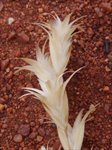
T. glabra spikelets.
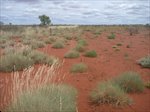
T. glabra habitat.

T. glabra leaf section.
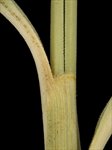
T. glabra orifice, eastern form with almost glabrous orifice.
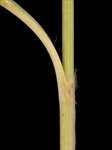
T. glabra orifice, western form with short but distinct orifice hairs.

T. glabra glumes.
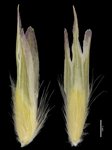
T. glabra lemmas.
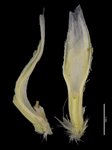
T. glabra paleas.

T. glabra map.
Name
Triodia glabra B.M.Anderson & M.D.Barrett, ined.
Citation
Austral. Syst. Bot., in press, (2017)
Derivation
glabra — from the Latin glaber (hairless, bald) in reference to the most common state of this species with glabrous leaf sheaths and orifices.Common name
Western Sandplain Spinifex
Synonyms
Triodia sp. Peedamulla (A.A. Mitchell PRP 1636)Diagnostic features
Foliage non-resinous; leaf sheath surfaces glabrous; orifice glabrous or rarely with ±straight hairs up to 2.5 mm long; leaf blades amphistomatous (hard-type), the longest ones usually >15 cm long; lower glume elliptic, 8–15-nerved; lemmas lobed for at least half their length, not awned, bitextured (strongly differentiated into indurated lower part and membranous upper part); distribution on sandplains of the western Pilbara, and the Carnarvon bioregion.
Habitat
Occurs on sandy to clayey soil in sand plains, dunes or coastal sands.
Distribution and frequency
Endemic to sandplains of the far western Pilbara (western extremities of Roebourne West, Chichester and Hamersley West sub-regions) and the Carnarvon sand plains, including coastal populations occurring near and south of the Cape Range, and the north-western Gascoyne bioregion.
Similar species
Triodia glabra belongs to the Basedowii group, sharing the group features of non-resinous foliage, amphistomatous (hard-type) leaf blades and many-nerved (≥6) glumes.
Triodia infesta, T. mallota and T. plurinervata differ in having unbranched inflorescences and short pedicels <3 mm long (inflorescences branched and longest basal pedicels more than 3 mm long in T. glabra).
Distinguished from T. chichesterensis, T. scintillans and T. vanleeuwenii by having longest leaves >15 cm long, (usually <11 cm long in the other species), lacking sparking droplets on young leaf sheaths (present in T. scintillans and T. vanleeuwenii), and distribution in the west Pilbara and Carnarvon region (the other three species occur in the central and east Pilbara).
Similar to the Little Sandy Desert species T. birriliburu in having glabrous leaf sheaths and glabrous to shortly pubescent (not woolly) orifices, but differs in having lemmas strongly differentiated into indurated lower part and membranous upper part (mostly indurated and scarcely differentiated into the slightly thinner apex in T. birriliburu), paleas strongly bent in profile with the rachilla appressed (flattened and with rachilla strongly diverging in T. birriliburu) and lemmas lobed for at least half their length (lobed for less than 1/3 of total lemma length in T. birriliburu).
Triodia basedowii is similar but has woolly hairs at the orifice (glabrous or less often with ± straight hairs up to 2.5 mm long in T. glabra), these extending onto the base of the leaf blade in T. basedowii (never doing so in T. glabra).
Previously confused with Triodia lanigera which is disjunct in the central-north Pilbara, but the two species can be distinguished by leaf orifice hairs glabrous or less often with ± straight hairs up to 2.5 mm long in T. glabra, compared to woolly in T. lanigera; the woolly hairs in T. lanigera usually also extending to the sheath surfaces.Conservation status
Not considered at risk.
Identification without florets
Triodia glabra is one of only four members of the Basedowii group in the western Pilbara and surrounds, the others being T. basedowii, T. mallota and T. plurinervata. Triodia mallota and T. plurinervata differ in having unbranched inflorescences and short pedicels <3 mm long (inflorescences branched and longest basal pedicels more than 3 mm long in T. glabra and T. basedowii). Triodia basedowii is nearly restricted to the eastern edge of the area considered here, disjunct from T. glabra.Variation
The western coastal populations have some morphological differences (e.g. smaller spikelets and shorter lemma midlobes compared to lateral lobes) from those to the east of Exmouth Gulf, but there is overlap. DNA sequences (Anderson et al. 2016) do not distinguish between populations in the two areas, but genomic data (Anderson et al. 2017b) suggests some differentiation between them.
Notes
Triodia glabra was variably considered under a broad concept of either T. basedowii or T. lanigera by Lazarides (1997), Lazarides et al. (2005) and Ausgrass (Sharp & Simon, 2002; Simon & Alonso, 2014). A full description of T. glabra can be found in Anderson et al. (2017a).
Killed by fire and not resprouting (MB obs.).